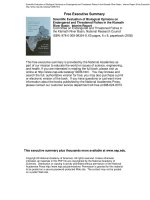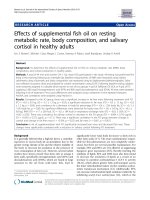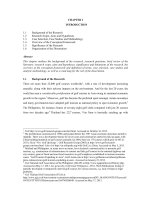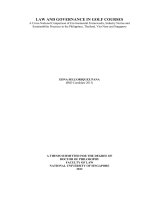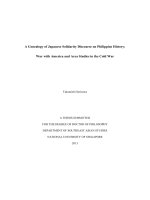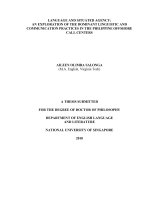A genealogy of japanese solidarity discourse on philippine history war with america and area studies in the cold war
Bạn đang xem bản rút gọn của tài liệu. Xem và tải ngay bản đầy đủ của tài liệu tại đây (1.34 MB, 243 trang )
A Genealogy of Japanese Solidarity Discourse on Philippine History:
War with America and Area Studies in the Cold War
Takamichi Serizawa
A THESIS SUBMITTED
FOR THE DEGREE OF DOCTOR OF PHILOSOPHY
DEPARTMENT OF SOUTHEAST ASIAN STUDIES
NATIONAL UNIVERSITY OF SINGAPORE
2013
i
ii
Ackowledgment
I would like to express my utmost gratitude to my supervisor, Professor Reynaldo C. Ileto,
who has patiently and warmly taken care of my Ph.D. project since the summer 2008. With his
inspiring mentorship, I could always feel excitement and happiness during my four and a half
years of study at the NUS. I want to dedicate this thesis to “Prof. Rey” as a part of my “utang,”
which I permanently owe him.
The academic staff of the Department of Southeast Asian Studies taught me a lot. It was
my great fun to join a department that allowed me to feel not strictly disciplined and that offered
students like me a rather loosely-structured, relaxed, but nonetheless challenging atmosphere all
the time. Particularly I want to express my gratitude to the Department’s Head, Associate Prof.
Goh Benglan, Associate Prof. Jan Mrazek and Dr. Julius Bautista for helping me to shape my
thinking in this academic journey. My thanks also got to my graduate colleagues. Preciosa de
Joya and Alice Yap always listened to me and encouraged my project when I faced problems.
Jun Cayron, Pitra Narendra, Wen Batocabe and Jay Cheong were the fellows from whom I
learned many things through the medium of beer. I also thank Associate Prof. Maitrii Aung-
Thwin and Professor Barbara Watson Andaya at the History Department for kindly introducing
me to important persons to contact during my U.S. fieldwork commenced in February 2012.
With their moral support my trip became a more meaningful one.
My U.S. archival work was kindly guided by the prominent librarians, Shiro Saito (in
Hawaii) and Susan Go (in Michigan). They introduced me to interesting and important sources
as well as welcoming me in my visits. Grant Goodman (in Kansas) and Pete Gosling (in
Michigan), retired professors who had worked on both Japan and the Philippines (Southeast
iii
Asia), shared their academic-life histories with me. Their “lectures” stimulated my curiosity,
which drove me to write up about the “same” origin of Philippine and Japanese Studies in the
United States.
Since I started my study in NUS, I rarely had the chance to go back to Japan. I did not see
my old professors at Tokyo University of Foreign Studies and Hitotsubashi University. Although
I did not meet them, my inner dialogues with them always kept going on. The following are the
Japanese scholars to whom I particularly want to express my gratitude: Professors Masafumi
Yonetani, Hidefumi Ogawa, Masahiko Okawa, Yoshiko Nagano and Satoshi Nakano.
Finally, I want to thank my family. My parents, Hisayasu and Fusae, did not hesitate to
send me the old books that I had ordered online many times. My younger brother and sister,
Masamichi and Hisako, visited Singapore several times instead of my having to go back to Japan
to see them. My wife, Rena, always supported me mentally and even financially. We got married
just before we came here to Singapore and I do not believe I could have completed my Ph.D.
project without her around.
iv
Table of Contents
Acknowledgement i
Summary v
Introduction: The Past and Present of Japan and the Philippines 1
Studies on the impacts of Japanese Occupation in Southeast Asia 7
Japanese Wartime Writings on the Philippines 14
Selection of Japanese Wartime Sources by U.S. Area Studies 19
Research Purpose and Organization of Chapters 23
Chapter 1: Japanese Wartime Use of Philippine History 28
Ki Kimura: Collecting Archives under the War 32
Japanese Use of Jose Rizal, Emilio Aguinaldo and Andres Bonifacio 38
Jose Ramos and His Tie with Japan 44
On National Name and Flag: Japanese Inquiring Eye on Filipino
Veterans and Historians 48
A Japanese Genealogy on Philippine History: Yukichi Fukuzawa (Meiji),
Motosaku Tsuchiya (Taisho) and Ki Kimura (Wartime Showa) 56
Summary 60
Chapter 2: Disseminating Tagalog: An Encounter between Filipino Revolution
and Japanese Rule 62
Tagalog for the Revolutionaries on the Eve of War 65
Need for the Middle Class 72
Inferior Scripts: Kana and Baybayin 77
Teodoro Agoncillo’s Madilim pa Umaga 84
Summary 88
Chapter 3: Friend and Foe Politics in the War: Japanese, Igorot, and U.S. Colonialism 90
American Identification of Igorot 93
Mining Development and Igorot-lowlander Politics 99
Igorot miners’ collaboration with the Mitsui Mining Company 102
An Igorot Guerrilla: Bado Dangwa 109
An Igorot Collaborator: Hilary Pit-a-pit Clapp 113
Summary 116
Chapter 4: Comparing U.S. Modernization Discourse on Japan and the Philippines (1945-
1960’s) 119
“Kindai”: Reification of a Western Concept 123
Questioning “Positionality” in Conducting Area Studies 131
The “Same” Origin of Japanese and Philippine Studies in the United States 137
Summary 143
v
Chapter 5: Dilemmas of a Japanese Historian: Tatsuro Yamamoto and
the Ghost of the Greater East Asian War 146
Tatsuro Yamamoto: Upbringing and Works 148
(Re)Birth of Southeast Asian Studies in Japan 151
Modernity and Morality: “Americanization” in Japanese Scholarship 158
Summary 167
Chapter 6: Translation and Destiny 170
Luis Taruc’s Born of the People: Translation by a Female Japanese
Communist 175
Gregorio Zaide’s Philippine History Text Book: Translation by a
Japanese Engineer 184
Yoshiyuki Tsurumi and Japan’s Contradiction with the Past:
Translating Renato Constantino 189
Shohei Ooka’s Compassion for Wandering, Starving, and Surrender
in the Forests 199
Summary 211
Conclusion 214
Bibliography 218
vi
Summary
This thesis examines the formation and reconstruction of Japanese knowledge on the Philippines
by paying attention to the various impacts of Japan’s war against America and its defeat. So
called “the Greater East Asian War” produced a large number of Japanese writings on the
Philippines from governmental-military reports to private literature. Previous works criticized
these writings as the products of a “wrong” history of what Japan did for Asian countries and
people during its imperial era. In particular, private Japanese wartime accounts such as travel
memoirs, essays and novels on the Philippines were simply disregarded due to their supposedly
“ethno-centric,” “self-deceiving” and “violent” characters. The first part of the thesis sheds light
on these “bad” Japanese accounts by tracing their roots in American colonial writings. The
second part looks into the development of Area Studies in the Cold War to demonstrate how a
postwar “forgetting” of Japanese wartime writings came about, contributing to a “disconnection”
between Japan and the Philippines.
1
Introduction
The Past and Present of Japan and the Philippines
Dean C. Worcester, a scientist in the fields of botany and zoology, who served as US
secretary of interior of the Philippines, once wrote a short essay on Japan in 1915 entitled “To
Our Near Neighbor in the Far East.”
1
Having visited Japan on fourteen different occasions
during which he observed how people lived in the cities and the countryside, Worcester begins
by expressing his impressions of the place:
I have met your great ruler Mutsu Hito
2
and others of your statesmen, and have been
impressed with their progressive spirit, the thoroughness of their knowledge, and the
saneness of their judgment. I have watched with sympathetic interest not the
“civilization” (Heaven save the mark!) but the modernization of Japan and have admired
the spirit in which you have met the manifold and complex problems which your recent
unprecedented progress has presented for your solution. [Worcester, 1915: 183]
(quotation marks and italics put in the original)
1
The article is compiled in a book edited by the President of the Japan Society of America, Lindsay Russell. The
book was published as a reply to its preceding publication from the Japanese side in 1914, Japan to America, written
in English. Japanese politicians and scholars contributed essays for promoting two nations’ friendship.
2
The name of Meiji Emperor.
2
Worcester uses the word “modernization” to name Meiji Japan’s successful development.
His disapproval of the use of the term “civilization” alludes to the fact that Japan’s development
is a unique example in Asia but not unique in terms of catching up with Western forms of
development. Modernization was an important task for him as a scientist as well as colonial
officer during his posting in the Philippines from 1901 to 1913. In particular, Worcester paid
much effort to the development of the non-Christian tribes in the islands. His autobiographical
book, The Philippines Past and Present (1914), spares many pages for his observations on the
problems and solutions in the development of non-Christian tribes and shows how he had
difficulties in bringing modernization to them.
It is worth noting, however, that Worcester’s positive assessment of Japan is entangled
with US territorial concerns in the Far East. He continues, then:
Not a few Americans have been obsessed with the idea that you would ultimately fight us
to get the Philippines. I confess to incredulity when some of your public speakers tell us
that you do not consider these potentially very rich Islands worth having. You know them
too well. Neither does it seem probable that your experiences in Formosa would deter
you from improving a really favorable opportunity to extend your possessions farther
southward. You are not so easily discouraged. But we believe that it would be foolish for
you to attempt to take the Philippines from us, and we do not believe that you are a
foolish people. With the opportunities for expansion which you now have, possession of
the Philippines would be a pitifully insignificant compensation for the moral
and material loss which would result were you thus to earn for yourself the hostility of
your oldest and best friend among the nations [Worcester, 1915: 186-187].
3
From this quotation, we can assume that Worcester thought of Japan as modern enough
not to entertain foolish thoughts about invading a US-held territory, the Philippines. Even after
the Philippines was declared pacified by Theodore Roosevelt in 1902, the Filipino-American
War did not end. Filipino revolutionary struggles against the United States persisted under the
leadership of figures such as Macario Sakay and Felipe Salvador.The rumor that Japan would
assist these Filipino revolutionary movements by invading the islands, had been seriously argued
in Philippine newspapers and constabulary reports during Worcester’s stay there. Around thirty
years later, during World War II, Worcester’s concern came true. Japan did invade the
Philippines in 1941 and occupied the islands until 1945.
Japan’s defeat in the war and the subsequent GHQ/SCAP occupation ensured that Japan
would never again be a danger to the United States in terms of territorial issues. Rather, Japan
has maintained a strong friendship with the United States through supporting its foreign policy
by hosting its military bases. With almost the same title as Worcester’s 1914 book, Edwin
Reischauer, professor of Japanese history at Harvard, who later served as US ambassador to
Tokyo, published his Japan Past and Present some 14 years later. Original drafts had been
written in Washington as early as the autumn of 1945, when the war had just ended. Upon its
publication in 1953, Reischauer reminded his readers that:
The chief addition I made in the portion of the text treating the prewar period was to
include an analysis of Japanese politics in terms of power groups within Japanese society
during the 1920’s and 1930’s. My principal change in interpretation was to stress those
forces opposed to the growth of democracy rather than the democratic tendencies
4
themselves. I did this not so much because of a change of my own views as because of
the need to adjust the argument to the reader. At the time I drafted the original manuscript
there was a marked tendency among Americans, and perhaps others as well, to overlook
the spontaneous growth of democracy in prewar Japan, whereas at the time I first revised
the text many people seemed instead to overestimate its strength. [Reischauer, 1953: x]
The force opposed to the growth of democracy is here identified as the Japanese
“militarists” who invaded China, interfered in the functions of democracy and turned the nation
into a fascist country. Reischauer’s major revision of the draft reflects the manner in which he
hooks Japan’s present (1953) onto the past. Postwar Japan was transformed into a democratic
state by the American elimination of those “bad” militarists from Japan’s politics during its
seven-year-occupation (1945-1952). Japan’s present is thus admirable for Reischauer as he can
find some continuity with prewar Japan’s spontaneous growth of democracy. From this
representation of the past and present, wartime Japan is off the tangent, afflicted with a malady
because it has strayed from the right track of democracy.
So as not to resurrect memories of Japan’s empire and in order to democratize the state,
the GHQ/SCAP operation invented the term “Pacific War” that does not mention Asia, while
banning the Japanese imperial but local term “Daitoa Senso” (the Greater East Asian War). Jun
Eto, a literary critic, writes that this change erased the presence and meaning of “Daitoa Senso”
and the voids were filled up such that the war was only waged between Japan and its Pacific rival,
the US. According to Eto, this change also brought a paradigm shift in postwar Japan’s
understanding of the past. It installed the imaginary conflict between “militarists” and “citizens”
5
in wartime Japan and it condemns militarists because they did wrong towards citizens, or people
who uphold their human rights in a democratic state. Furthermore Eto insists that this change
contributed to a “saintly” image of the Americans who should not share the blame at all for the
war, in spite of two atomic bombs in Hiroshima and Nagasaki along with other massive
bombings in main cities, because these bombings were considered just punishment for the
misdeeds of those bad Japanese militarists. He terms this understanding of the past “War Guilt
Infomation Program,” which encourages Japanese condemnation of their militarists and the
wartime traditional order while accusations of war culpability are never hurled against the US
because it had brought the democracy that enabled Japan’s transformation into a better state [Eto,
1994: 266-271].
Although Eto’s views differ from Reischauer’s on some points, what is clear is that both
allude to the establishment of a postwar narrative of Japan that is similar to other US liberation
discourses on Asia where the US needs to justify its interventions under the name of democracy,
peace, and modernization. For example, Filipino historian Reynaldo Ileto writes that his
immediate reaction to the US invasion of Iraq in 2003 was one of déjà vu. In analyzing US
President George Bush’s speech to the Philippine Congress on October 2004, which called for a
Filipino-American joint struggle against terror, Ileto finds clear echoes of the discourse
employed by the Americans in the past upon their liberation of the Philippines from two “bad”
rulers. The first time was in 1898 when US forces came to fight alongside the Filipino
revolutionists against Spanish tyanny and the second one was in 1945 when the Americans
returned to get back the islands from the Japanese invaders. The first liberation event was led by
Arthur MacArthur and the second one by his son, Douglas. Ileto observes that the Filipino-
American War, which was just as terrible as the Filipino wars against Spain and Japan, is totally
6
suppressed in this US liberation narrative. In the Iraq war that frames Bush’s speech, the Spanish
and Japanese tyrants of the past have merely been replaced by the dictator Saddam Hussein and
his imagined weapons of mass destruction [Ileto, 2005: 215-216, 231-233].
In the inside cover of the 1921 edition of Worcester’s The Philippines Past and Present,
the author juxtaposes two pictures of an native man, named Hilary Pit-a-Pit Clapp, from Bontoc
in Mountain Province, Northern Luzon. One was taken during Clapp’s childhood, when he was
called merely “Pit-a-pit,” in which he faces the camera with a big smile, clothed in a G-string
and with rough hair. The other photo was taken after nine years of education by the Episcopalian
Church run by American pastors. Now Clapp is shown wearing a white suit with pomaded hair
cleanly cut. He stares at the camera sternly as a man who has the Western name, Hilary Clapp.
Looking at the pictures, we can see how Worcester believed that wild tribes in the Spanish
colonial period can evolve into sophisticated people through the benevolence and tutelage of
American colonialism.
In both books, Worcester’s on non-Christian tribes in the Philippines and Reischauer’s on
postwar democratic Japan, we find some similarlity of US liberation discourse. In each case, US
patronage was successful since their clients responded in the prescribed manner. We find here
the self-pride of American tutelage through its narratives on the past and present of the other in
Orient.
In 1942 under the Japanese occupation, Clapp was appointed as the first “native”
governor of Mountain Province and killed by one of guerrilla groups in April 1944. Although
Clap exemplified a successful product of US colonialism, what turned him into a “collaborator”
with Japan? His life is treated in detail in a later chapter but before we can answer this
7
FromDeanC.WorcesterPhilippinesPastandPresent(1921)
question we need to critically review how the Japanese occupation period in Southeast Asia has
been studied in the US academe and how this contributed to the creation of a liberation discourse.
Studies on the Impacts of Japanese Occupation in Southeast Asia
Scholars of Southeast Asian history have paid a keen interest in knowing the impacts and
aftermaths of World War II, when Japan directly or indirectly ruled the region. In spite of the
fact that Japanese occupation lasted less than four years (1941-1945) and that this time span is
much shorter when compared with occupations by Western colonial powers that preceded
8
Japan’s, the latter’s history has been widely and intensely studied and several controversies about
it have ensued.
It was scholars from “West,” having affiliations with the universities in Northeast
America and Western Europe, who first launched this topic just right after the war. Their concern
about this period was simultaneously related with the fact that many countries in Southeast Asia
gained independence after WWII, whether or not this followed upon armed resistances against
the former suzerain countries. In other words, the new beginnings of these formerly colonized
countries became the research target of scholars who themselves emerged from Western imperial
world.
Scholars from the United States were particularly assertive about engaging in this study.
Their historical research was not simply devoted to the past but was greatly motivated by the
desire to understand the ongoing politics in these new-born countries under the shadow of the
Cold War. As an extension of America’s national security interests, their utmost concern was to
prevent communism from spreading in the region. So called “modernization theory” was largely
referred to by American scholars seeking to explain historical developments in the region. The
theory locates non-Western countries’ political and economic development along the path of that
had been traversed by developed Western countries [Adas, 1989; Keys, 1992; Latham, 2000;
Berger, 2003].
With a particular focus on anti-colonial movements in Indonesia under the Japanese
occupation, Harry Benda, Josef Silverstein, Benedict Anderson and other leading scholars argued
that Japanese rule brought fundamental change to the political structure of the Dutch East Indies,
which led to postwar independence movements [Elsbree, 1953; Benda, 1958; Silverstein ed.,
9
1966; Anderson, 1966; Kanahele, 1967; Reid, 1975]. This perspective was widely applied to
other countries’ cases. Dorothy Guyot pointed out that the Burmese Independence Army,
Japanese-sponsored in WWII, became the established force for postwar society [Guyot, 1966].
David Steinberg used the same term of change but with a negative nuance, criticizing the
Filipino elites’ collaboration with Japan which led to severe corruption, nepotism and bribery in
postwar Philippine politics [Steinberg, 1967]. The Japanese occupation was first considered as a
“watershed” after these early studies by American scholars. The so-called “change” thesis was
the mainstream doctrine during the 1950’s and 1960’s.
In the book he edited, Southeast Asia under Japanese Occupation, published in 1980,
Alfred McCoy reconsidered this dominant narrative by focusing on the local elite politics in a
province in the Philippines. According to McCoy, the divide between the Iloilo political elites
was not established by the tendency to either collaborate with or resist against the Japanese. It
occurred inside each sector because two rival factions sent their staffs to each camp. In the
prewar period, their conflicts did not involve violent actions due to the effects of American
democratic tutelage. But after the United States Army Forces in the Far East (USAFEE)
surrendered in May 1942 to the Japanese military force, the Iloilo political elites were not any
more under the control of the Americans. They even perpetrated some of the killings during the
Japanese occupation. This to McCoy was evidence of the fact that Western democracy had not
been established in the Philippines. He then concluded that the Japanese occupation in Panay city
did not bring any fundamental change in the factional nature of the political structure [McCoy,
1980: 233-234].
10
McCoy’s framework was applied by Robert Taylor to Burma and David Marr to
Vietnam—at least in their essays contained in McCoy’s edited volume—in order to demonstrate
the continuity of elite politics through both the wartime and postwar periods [Taylor, 1980; Marr,
1980]. They argued that the “changes” that occurred after WWII should not be overly attributed
to the Japanese invasions because they had already been determined by the prewar elites’
factional divisions. To Japanese scholars studying the Japanese occupation in Southeast Asian
history, this “continuity” thesis has been very influential as well. They have referred to McCoy’s
work in establishing their new findings [Goto, 1989; Kurasawa, 1992; Ikehata, 1996a;
Kawashima, 1996; Nakano, 2001]. In fact, McCoy’s thesis replaced the “change” school
regarding the mainstream doctrine and it is hard to say if there have been new or alternative
approaches for more than three decades since McCoy’s critical inquiry.
It is not my intention to determine the validity, or otherwise, of the “change” or
“continuity” arguments in terms of examining the impacts and aftermaths of WWII in Southeast
Asia. Rather I intend to examine the scholarly discourses on the Japanese occupation in
Southeast Asia, whether by Americana, Japanese, or Filipinos, as historical products themselves.
For example, the above “change” school might have been persuasive for American scholars from
the 1950’s to the 1960’s when they witnessed the births of fresh (and not anti-American)
nationalism, economic recovery from war devastation, the Asia-Africa Conference, and the
establishments of SEATO and ASEAN. These changes in Southeast Asia might be judged as
“ordinary” developments or being on the “right track” with (implicit) reference to the historical
experience of Western democracy and modernization. This may also explain Steinberg’s critical
attitude toward the Philippines as a country that already had the experience of learning these
Western ideas in the prewar period, but failed to implement it properly in the postwar period.
11
The earlier postwar moves toward independence and democracy in Southeast Asia were
also, more or less, counter-measures against communism. But, later, Communists in Vietnam
revolted against US intrusion. Furthermore many countries in Southeast Asia kept falling into
military rule and dictatorships. Corruption in governments and economic stagnation in industries
were then diagnosed as “abnormal” characteristics of Southeast Asia. The continuity thesis thus
gained even more persuasiveness and popularity, at least for American scholarship, in explaining
the “non-democratic” and thus “not like us” elements appearing in the region.
Although his critical inquiry was addressed to Europe or the idea of Europe, Dipesh
Chakrabarty’s note on history as academic discipline might be helpful for us here in
reconsidering the change versus continuity debate in American scholarship. He says:
It is that insofar as the academic discourse of history—that is, “history” as a discourse
produced at the institutional site of the universities—is concerned, “Europe” remains the
sovereign, theoretical subject of all histories, including the ones we call “Indian,”
“Chinese,” “Kenyan,” and so on. There is a peculiar way in which all these other histories
tend to become variations on a master narrative that could be called “the history of
Europe.” [Chakrabarty, 2000: 27]
The history of Europe is the “canon” for the academic discourse of history that subjugates
the other histories as variations of this master narrative. I want to replace Chakrabarty’s use of
“Europe” with “America” and “history” with “area studies” to shed a light on the politics of
writing about the WWII. In other words, my aim in this thesis is to explore the kinds of
12
discourses on the war that have been allowed (or rejected) for circulation in the process of
establishing the “centrality” of US Area Studies.
Japanese Area Studies on Southeast Asia, a “peripheral” product of US Area Studies, has
assertively imported approaches from the United States. This attitude has stemmed from Japan’s
self-reflection on the war. In the introduction of Nihon Senryoki Indonesia Kenkyu (A Study on
Indonesia during the Japanese Occupation), Kenichi Goto, who earned his MA at Cornell in
1970, confesses to his hesitation engaging in the topic:
In the academic community in Japan, particularly among the historians, as is also
indicated in the introduction by Nishijima and Kishi,
3
the study of military administration
as a main topic has been regarded as taboo in view of the past relations with Asian
countries. Furthermore, their negative attitudes stem from the fact that several scholars in
the field of Social and Humane Studies were once “mobilized” in the services of military
rule in nanpoh. [Goto, 1989: 19]
Postwar Southeast Asian Studies inevitably invoked Japan’s “dark” memory of the study
of “nanpo,” an imperial Japanese concept representing Southeast Asia and Oceania, which
mobilized scholars for the Japanese military rule. Due to this trauma, the Japanese occupation
was not chosen as a topic in the early stage of Southeast Asian Studies in Japan. This is the total
3
Shigetada Nishijima and Koichi Kishi collected huge amounts of Japanese military documents on Indonesia and
published in Japanese in 1959. Based on this book, Harry Benda, with the help of James Irikura, published the
English version in 1965. The brief background of the project will be explained in the following.
13
opposite of Southeast Asian Studies in the United States, which had already initiated this kind of
study in the late 1940’s.
In order to distance themselves from the previous imperial scholarship on nanpo, Japanese
scholars have needed to learn new approaches practiced by US Area Studies. Aiko Kurasawa,
another Indonesia specialist studying the time of Japanese occupation who obtained both her MA
(1978) and Ph.D.(1988) from Cornell, reveals her perspective in her book titled Nihon Senryoka
no Java Noson no Henyo (Changes in Javanese Villages during the Japanese Occupation). She
relates her study to the previously discussed change-continuity debates as follows:
This book uses the word “change” not as temporary phenomenon but as a non-invertible
one, which will be passed on to the next generation as “evolutionary process.” In this
sense, rather, I do not limit my study to examine changes in the time of (Japan’s) military
regime. The periodization separating the before and the after August of 1945 is Japan-
centered and thus a ruler-oriented idea and I believe that in local people’s mind and
memory this period does not necessarily draw a line. [Kurasawa, 1992: 24]
Kurasawa here notes two important orientations in postwar Japanese scholarship on
Southeast Asia. One builds on “evolutionary process” and the other rejects a “Japan-centered
perspective” in historical writings. During the wartime days, the history of Southeast Asia was
studied in order to meet Japan’s need in ruling nanpo. “Kokoku-shikan” (Emperor-centered
historical perspective) was the foundation for narrating “solidarity” with fellow Asians, which
mandated a glorious history of Japanese empire. For the sake of not repeating the same mistake
and avoiding a Japan-centered perspective, as we will demonstrate, postwar Japanese scholars
14
applied modernization theory, an evolutionary paradigm and linearity, which had become articles
of faith in objective historical studies by US Area Studies practitioners working on Southeast
Asia.
Japanese Writings on the Philippines in WWII
As briefly summarized here, postwar Japanese scholars studying Southeast Asia started
out by distancing themselves from the wartime and thus Japan-centered perspective of
previous imperial studies. Postwar Japanese pioneering scholars of the region also locate the
beginning of Japanese studies of Southeast Asia in 1966 when the “Tonan Ajia-shi Gakkai”
(Japan Society for Southeast Asian History) was created [Yamamoto, 1997; Sakurai, 2009]. Toru
Yano, the pioneering scholar of Japan’s southward advance policy (nanshinron), produced a
series of works that criticized Japanese wartime writings in the 1930s and 1940s. According to
him, the writings were “ethno-centric,” “self-deceiving” and “violent,” and the distortion of
history was also quite characteristic of the works done by Japanese intellectuals during this era
[Yano, 1975; 1979; 1980].
This kind of framework has been influential in the later works of Japanese wartime
writings related to the Philippines. Shinzo Hayase (1989) uncovers the absence of historical
proof to support the heroic narrative of Japanese construction workers for building the Benguet
roads and reveals its mythical character. Lydia Yu-Jose (1999) analyzes several Japanese
writings on the Philippines that appeared in the first half of the twentieth century and shows how
these accounts assess Filipinos as backward people while empathizing with American
colonialism. She also argues that this earlier Japanese view in peacetime was carried forward
15
during the Japanese occupation with its violent methods employed to bolster notions of Japanese
supremacy in the Philippines.
Setsuho Ikehata has introduced some Japanese perceptions on the Philippine revolution
and the war against America by referring to Japanese accounts that appeared contemporaneously
with that event [Ikehata, 1989; 2003]. But she does not discuss the Japanese “revisiting” and
“reprinting” of these accounts that were greatly encouraged during WWII. Ikehata’s edited book,
Nihon Senryōka Philippine, published in 1996, is the first comprehensive collection of Japanese
scholarly writings on the Japanese occupation utilizing new Japanese sources and interviews
with important survivors [Ikehata ed., 1996]. However, most of the articles in the volume use
mainly military or governmental reports for understanding Japan’s economic policy. They hardly
tap sources such as non-fictional novels, travel memoirs, essays and Japanese translations of
existing literature, which we will discuss in this thesis. Motoe Terami, a contributor to Ikehata’s
book, seems to be the sole Japanese scholar with an interest in cultural encounters between
Japanese and Filipinos during the war using both Tagalog and Japanese sources. However, her
concern is limited to Japan’s propaganda activities and their successes and failures [Terami-
Wada, 1990; 1991; 1996; Terami, 1996; 2001].
The main purpose of previous studies has been to criticize Japan’s imperial interests and
practices in the Philippines through reviewing Japanese accounts in WWII that were considered
unreliable and that distorted our understanding of Philippine history. Examples would be
accounts that accommodated pan-Asianism and the emancipation of Asia from the West under
the Japanese empire. It is true that Japanese writings, especially those that appeared in the
wartime period, advocated such a self-centered perspective of history.
16
In terms of Japanese writings on the Philippines, booms or surges in publication emerged
twice under similar circumstances: resistance against Western supremacy. The first surge
occurred during the late Meiji period of the Philippine Revolution (1896-98) and the subsequent
resistance of the Filipinos against United States cccupation that took place from 1899 to 1902.
The second surge was at the time of WWII from 1939 to 1945, when Japan occupied the
Philippines and fought against the US and its allies. During the latter period, more Japanese
writings than ever about the Philippines were produced, ranging from government reports to
private memoirs.
4
Previous studies – intentionally or otherwise – have treated the Meiji’s solidarity with the
Philippines differently from that of wartime Showa or the WWII period. In fact the Meiji
solidarity has been widely and richly studied. The discussions have focused on several Japanese
friendships with, and efforts to help, Filipino revolutionaries that were found in historical
accounts, including novels written during the era [Yanagida 1961; Hatano 1988; Ikehata 1989;
2003; Yu-Jose 1999; Yamashita 2000; Shimizu 2007; Hau; Shiraishi 2009]. In contrast, the
Japanese solidarity discourse on the Philippines in WWII has attracted less scholarship, and even
if studied, this solidarity is usually examined as a transplantation of Japanese wartime ideology
4
According to the survey by Shinzo Hayase, the number of Japanese publication on the Philippines increased from
the late 1930s. When “the Greater East Asian War” occurred, the number drastically increased and there were
around two hundred items published within the year 1942 [Hayase 2009: 9]. Furthermore, Japanese novels on the
Philippines written during the Philippine Revolution were almost all reprinted, read by the public and re-examined
by critics during the time of WWII. This boom was much larger than the preceding one and it also produced several
new books and translations on Philippine culture, economy and history. The reason for a large quantity of Japanese
knowledge production on the Philippines can, of course, be traced to Japanese imperial power. Hayase draws our
attention to the fact that these Japanese wartime accounts, including war memoirs, have been judged by postwar
Japanese scholarship as not necessarily “trustworthy” in their contents and also including some “unreliability” as
historical accounts. In fact, previous works have simply dismissed or criticized these accounts as the products of a
“wrongful” history of what Japan did for Asian countries and people during its imperial era.
17
onto the Philippines, or treated simply as propaganda [Goodman, 1991; Terami-Wada, 1990;
1991; Yu-Jose, 1999; Terami 2001; Jose 2003].
The question is why the Meiji era’s solidarity with Filipinos and that of the Showa in
WWII are approached by historians in such a different manner. It seems to me that the former
solidarity has captured scholars’ interests because the Meiji discourse was for a “weak” Japan
and the Philippines. On the other hand, the Showa’s solidarity with Filipinos was “ideologically
wrong” or even “ill-minded” because Japan was non-democratic, militarist and thus a fanatic
empire that brought huge disaster to and victimized the Philippines. All publications in WWII
were also under the military’s censorship and Japan’s eventual defeat in the war further
“stigmatized” the pious image of wartime Showa’s solidarity with Filipinos.
Certainly, answering these questions definitively is beyond the scope of my preliminary
research. But as I have reviewed here, there have been some disconnections between Japanese
wartime and postwar studies on the Philippines and Southeast Asia. Or, to state this more
concretely, Japanese wartime studies that searched for a fundamental Japanese tie with peoples
in nanpo, were dismissed as flawed or even unspokenly banned from scholarly examination
during the period of the emergence and development of postwar Japanese scholarship on
Southeast Asia. My purpose in this thesis is not to resurrect Japanese wartime narratives and
studies on nanpo with a view to reevaluating them from a “nationalist” perspective, as a
superficial critic of this thesis might decry. Rather, I believe that if the Greater East Asian War
was a mistake, we need to examine the formation of Japan’s Asiatic discourse, its genealogy and
effects, and not sweep it under the rug as the product of Japanese ultra-nationalism and an
aberration best forgotten.
18
I would like to put forward a disclaimer: It is not my intention to put a label on any
ideology or propaganda in a bid to analyze Japanese wartime accounts on the Philippines. I aim,
rather, to shed light on several “accidents” that were by-products of Japanese knowledge
production about the Philippines during WWII. I also focus on the Meiji- and Taisho-era
solidarity discourses in order to understand the relation between these discourses and that of the
Showa solidarity discourse. My concern here is not a developmental history of how the
discourses evolved in later periods. Rather, in an opposite way, I hope to uncover how Meiji and
Taisho solidarities were revisited and appropriated by the writers in the wartime Showa era.
5
Fomented by the “genealogists” Nietzsche and Foucault, this study does not search for the
origins of the Japanese solidarity discourse on the Philippines in the Meiji era and trace its
expansion in Taisho and final explosion in the wartime Showa, as what previous studies have
demonstrated.
6
Rather, I will argue that the discourse emerged, or more accurately, was formed,
at every moment, in relation to the American colonial knowledge and its grip of power on the
Philippines.
Reynaldo Ileto has pointed out that the history of the Philippines was reconfigured by
American colonial scholars and officials on the occasion of the pacification of the islands. A new
5
A typical example is Suganuma Teifū (1865-1889). He was an unknown character in his time but came to be seen
as a saint under the “Greater East Asian War.” His works, Shin-Nihon no Tonan no Yume (1888) [new Japan’s
dream of aspiration to the south sea] and Dainihon Shōgyōshi (1892) [History of Commerce in Great Japan], stating
Japan and China’s cooperation for developing the South, were compiled in a book in 1940 and first publicly
recognized at the eve of the war. He died in Manila at the age of twenty five and this early death also helped in
mystifying his character during WWII.
6
I am particularly in debt here to Foucault’s famous essay “Nietzsche, Genealogy, History.” Foucault defines
genealogy as one that “does not resemble the evolution of a species and does not map the destiny of a people. On the
contrary, to follow the complex course of descent is to maintain passing events in their proper dispersion; it is to
identify the accidents, the minutes deviations, the errors, the false appraisals, and faulty calculations that gave birth
to those things that continue to exist and have value for us; it is discover that truth or being do not lie at the root
what we know and what we are, but exteriority of accidents” [Foucault 1977: 146].


